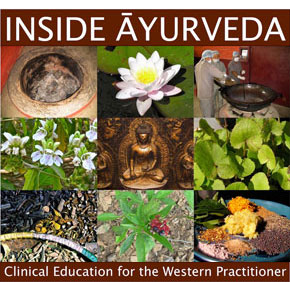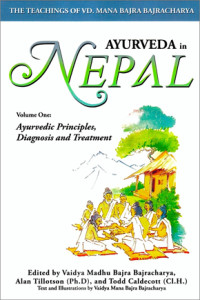Triphala is commonly available as a churna, a finely sieved powder that can be mixed with water, ghee (clarified butter) or honey, but can also be encapsulated for sensitive palettes. There are many methods of preparing Triphala however, including medicated oils, decoctions, confections, and natural fermentations (asava/arishta). TAM designates Triphala as a rasayana, a Sanskrit term given to those medicaments that improve general health and prolong life. For this purpose it is traditionally prescribed for up to a year in doses of 1 – 2 grams taken twice daily, and may even be taken throughout one’s life on a semi-regular basis to cleanse the tissues, strengthen digestion, and sharpen the senses. Care must be taken when purchasing Triphala to ensure that the product is fresh, as churnas (powders) are traditionally said to have a shelf life of no more than six months.
Classical Uses for Triphala
Triphala is revered among the many other rasayanas for its reliable and balanced activities. It is so safe to use and so highly valued for its efficacy that a common aphorism among many TAM practitioners is “when in doubt, use Triphala.” Ancient authors noted that it contains every taste except salty, and acts to promote a state of balance between the humoral principles (i.e doshas) of Vata, Pitta, and Kapha. Each component of Triphala has a specific activity on a particular dosha: Amalaki fruit is considered to be a rasayana for Pitta; Bibhitaki a rasayana for Kapha; and Haritaki as a rasayana for Vata. Triphala is also considered to be malashodhana, removing (shodhana) the toxic wastes (mala) of poor digestion that remain in the body, called ama. The indications of ama include a thick greasy coating on the tongue, poor appetite, indigestion, constipation, joint pain, headache, orbital edema, sinus congestion, a feeling of coldness, mental confusion, and lethargy. The routine use of Triphala each morning is thought to detoxify the body and restore the integrity of the entire digestive tract, with a perfect balance between its astringent, demulcent, digestive, and aperient properties. In the most authoritative extant text on Ayurvedic medicine, the Charaka Samhita (c. 8th Cent. BCE) describes Triphala churna as rejuvenating medicament that can be used alone or in formulation. One simple recipe described by Charaka is to prepare a paste of Triphala churna with water and smear it within an iron vessel, where it is kept for 24 hours. The paste can then be taken with honey and water, followed with clarified butter. Charaka states that “by using this recipe continuously for one year, one can live for a hundred years, free from aging and diseases” (1). In the Sharngadhara Samhita, a 14th century (CE) text on pharmacy, Triphala churna is said to be comprised of one part Haritaki, two parts Bibhitaki, and four parts Amalaki (2). Sharngadhara states that when taken with honey and ghee, Triphala is a rasayana and an effective stimulant to digestion, acting to reduce the vitiation of Kapha (leading to congestion) and Pitta (leading to inflammation) (3). In contrast to this latter text, the Ayurvedic Formulary of India states that Triphala churna is prepared by mixing equal parts Amalaki, Bibhitaki, and Haritaki (4). The Formulary suggests a dosage of 3 – 6 g, taken with ghee, honey, and/or warm water in the treatment of anaha (flatulence and constipation), prameha (diabetes), and netra roga (diseases of the eye) (5). There is no need to be concerned about the apparent incongruity in the composition and dosage of Triphala listed in the various sources. Based upon the reflection of thousands of years of usage in a wide variety of conditions, most trained practitioners will modify the specifics of formulation and dosage in concert with particular conditions. In the treatment of a Vataja condition such as anaha (flatulence and constipation) for example, the ratio of Haritaki to Bibhitaki and Amalaki would be increased so as to allow for a more aperient activity. Regardless of these subtleties however, most practitioners will agree that in small doses (1 – 2 g) Triphala churna is a rejuvenating alterative safe for long-term use, whereas in large doses (10 –15 g) Triphala will typically have an aperient or purgative property, used for shorter periods of time. This purgative application is generally thought to be safe and effective even for geriatric and pediatric use because the rejuvenative properties of Triphala offset the potentially debilitating effects of purgation. The properties of Triphala also change according to the anupana (lit. “vehicle”) with which it is consumed. An anupana is a substance that enhances the absorption of the remedy and directs towards the alleviation of a particular dosha or condition. The most common anupana includes ghee, honey, and warm water. In the treatment of Vataja conditions, Triphala churna is best mixed with 2 parts ghee and one part honey, after which it is followed with warm water. Pittaja conditions require only ghee to be used, and Kaphaja conditions benefit from honey as an anupana, followed by warm water after ingestion.
Classical Formulations
Triphala is included as an essential part of variety of classical Ayurvedic formulations. As a simple rasayana, the Charaka Samhita suggests equal parts Triphala, Madhuka flower (Madhuka indica), Tvakshiri sap (Bambusa arundinaceae), Pippali seed (Piper longum), ghee, honeyand raw sugar (6). In a similar fashion, the Ashtanga Hrdaya (c. 6th cent. CE) recommends a combination of Madhuka flower (Madhuka indica), Tvakshiri sap (Bambusa arundinaceae), Pippali (Piper longum), Saindhava (rock salt), Suvarna (purified gold), Vacha rhizome (Acorus calamus), and Loha (purified iron), mixed with equal quantities of Triphala. The preparation may be taken with honey, ghee, or sugar, and when taken regularly “acts as a rasayana, cures all diseases, bestows intelligence, longevity and good memory” (7). Triphala mixed with Patola leaves (Trichosanthes dioica), Vasaka leaf (Adhatoda vasica), Guduchi stem (Tinospora cordifolia), Katuka rhizome (Picrorhiza kurroa), and Vacha rhizome (Acorus calamus) can be used as a decoction for treatment of fever with cough and mucus (Pitta and Kaphaja fever) (8). Mixed with Nimba leaf (Azadirachta indica), Madhuka flower (Madhuka indica), Katuka rhizome (Picrorrhiza kurroa), Rajavriksa pods (Cassia fistula), and honey, Triphala can be given as a decoction to alleviate pain and/or fever with a burning sensation (Pittaja fever) (9). If the fever is very high with convulsions or tremors (i.e. Pittaja and Vataja), Triphala may be combined with Shalmali bark (Salmalia malabarica), Rasna (Vanda roxburghii), Rajavriksa fruit pulp (Cassia fistula), and Vasaka leaf (Adhatoda vasica) (10). Applied topically, Triphala is a strong agent for wound healing. K.M. Nadkarni’s modern classic Indian Materia Medica recounts how a surgeon named Dr. A. Lakshmapathi applied Triphala powder to a cut he sustained from a dirty razor, and covered it with a bandage. The cut completely healed within 72 hours with no evidence of a scar. Subsequent to this, Dr. Lakshmapathi routinely applied a dusting of Triphala powder for healing fresh surgical wounds with great success (11). I have also had occasion to use Triphala as a dressing for wounds, with similar results. In the treatment of inflammatory skin eruptions (erysipelas) and severe fevers, Chakrapani’s famous Ayurvedic recipe book Chakradatta suggests a preparation Triphala, ghee, and the Pitta-reducing laxative Trivrit root (Operculina turpenthum) (12). Chakrapani furthermentions that if the eruptions are mucopurulent and inflamed, Triphala can be mixed in equal parts with the Kapha-reducing Guggul resin (Commiphora mukul). This formula can also be used topically to heal wounds that are large and painful with suppuration and discharge (13). Ulcerous sores, including herpes and syphilis, can be washed with Triphala decoction (14). For urticaria and other skin allergies, purgation with a large dose of Triphala, Guggul resin (Balsamodendron mukul) and Pippali seed (Piper longum) can be performed during the initial stages of treatment. This can then be followed with continuing smaller doses of Triphala and honey taken twice daily (15). Triphala can be used for severe weakness or fainting due to the effects of disease or malnourishment. A simple recipe given in Chakradatta is a dose of Triphala with honey taken at night, and fresh Ardraka root (Zingiber officinalis) with molasses in the morning (16). Mixed with purified Shilajatu (a bituminous secretion found on Himalayan mountain rock faces), Triphala can be used to prevent long-term complications of obstinate kidney diseases, including chronic nephritis, as well as diabetes (17). Inspired by its traditional use in the treatment of obesity, a clinical trial examined the efficacy of Triphala in the treatment of this condition, in combination Guggul resin (Commiphora mukul). According to the data obtained from this trial a significant degree of weight loss was observed, compared to placebo. (18) Triphala is considered an important medicine for eye health, especially blurred vision (due to early stages of refractory error or unknown causes), or inflammation in the fatty layer lining the orbit. It can be used as a powder or a paste (by mixing with ghee) or as a decoction. The finely filtered decoction can be used as a morning eyewash. The Ashtanga Hrdaya suggests a preparation called Maha Triphala ghrita in the treatment of eye diseases, prepared by combining Yashti madhu root (Glycyrrhiza glabra), Kshirakakoli bulb (Lilium polyphyllum), Kakoli bulb (Fritillaria roylei), Vyaghri root (Solanum xanthocarpum), Pippali seed (Piper longum), Guduchi stem (Tinospora cordifolia), Utpala tuber (Nymphea stellata), Chandana wood (Santalum album) and Draksha fruit (Vitis vinifera). To this is added the fresh juice of Triphala, Vasaka leaf (Adhathoda vasica) and Markava leaf (Eclipta alba), with equal parts ghee, and goat’s milk. The Ashtanga Hrdaya says that “the person who consumes (this formula) daily at night, along with the powder of Triphala and Yashti madhu (Glycyrrhiza glabra) soaked in honey, followed by a decoction of Amalaki, for one month… obtains eyesight similar to that of an eagle” (19). In one of the most important modern formularies of Ayurveda, the Bhaishajyaratnavali (1893) suggests a formula called Saptamrita Lauha (“sevenfold nectar”) in the treatment of timira (blindness) (20). Composed of Yashti madhu root (Glycyrrhiza glabra), Triphala, lauha bhasma (purified iron), ghee, and honey, the efficacy of Saptamrita Lauha was assessed in a clinical trial of 48 retinopathic eyes. The formula was found to be highly effective, with the rapid clearing of retinal hemorrhaging, observed in both diabetic and hypertensive subjects. In three eyes the hemorrhage was cleared completely. The recurrence of a hemorrhagic episode was found to be statistically lower in eyes treated with Saptamrita Lauha (21). Triphala churna can also be applied for dry massage, particularly suitable in the treatment of Kapha conditions. Mixed with water it can be employed as a shampoo, a gargle (kabalagraha), or for nasal administration (nasya). As a decoction it can be employed for enema (vasti). Triphala churna is also useful as a rapid-acting expectorant, prepared by infusing 5 g of the churna in 300 mL of water overnight (22). Consumed first thing in the morning upon arising, a dramatic expectoration follows within minutes.
Scientific Studies on Triphala
According to a research review done by the Central Council for Research in Ayurveda and Siddha, Triphala was found to be non-toxic. Animal studies have shown that Triphala increases growth in young animals, and stimulates the increased consumption of feed and water. Triphala has been shown to increase the mass and contractile strength of the heart, with no adverse effects noted through blood analysis. Triphala was found to reduce inflammation caused by toxins and by arthritis, and reduced pain and writhing in animals poisoned with acetic acid. In large doses Triphala was found to be hypoglycemic. (24) We will review the traditional uses and scientific evidence below specific to each of the fruits that comprise Triphala.
Amalaki Fruit
Phyllanthus emblica (Euphorbiaceae) is a medium-sized attaining a height of about 8 meters, growing wild or under cultivation throughout tropical and sub tropical South Asia. In India it is commonly found on the Deccan plateau, the sea coasts, and Kashmir, and has been found to be especially abundant in Madhya Pradesh. Although the entire plant is medicinal, it is Amalaki (lit. “sour”) fruit that is commonly used in Ayurvedic medicine. The bright green fruits are said to have a sour, sweet, bitter, and astringent taste, with a cooling energy. Amalaki is considered to be a Pitta rasayana, with astringent, stomachic, carminative, alterative, immunomodulant, adaptogenic, antinflammatory, antimicrobial, antipyretic, and trichogenous properties. It is said to be especially good for the both the physiologic and emotional hearts, promoting longevity, good fortune and love. Traditionally, Amalaki fruit is used in the treatment of erysipelas, dyspepsia, gastritis, biliousness, hyperacidity, hepatitis, constipation, flatulent colic, colitis, hemorrhoids, bleeding disorders, alcoholism, menorrhagia, anemia, diabetes, gout, osteoporosis, premature greying, alopecia, convalescence from fever, asthenia, mental disorders, vertigo, palpitations, inflammation, cough, and asthma. (25, 26, 27, 28, 29, 30) Amalaki fruit comprises about 80% of the famous medicinal confection Chyavanaprasha, an ancient tonic used by all ages to improve mental and physical well being. According to the Charaka Samhita, this classic remedy is comprised of 42 other herbal ingredients, with the addition of ghee, sugar cane juice, sesame oil and raw honey (31). The unripened Amalaki fruits can be made into digestive-enhancing pickles (32). An infused oil of the dried fruit is used as a massage oil, particularly for the head to add lustre and strength to the hair, and in the treatment of premature greying and alopecia (33). Modern research shows Amalaki to contain extremely high concentrations of bioflavonoids and a heat stable form of Vitamin C, partially accounting for its esteemed reputation. TAM physicians designate this herb tridosaghna, a term that refers to a medicament’s ability to stimulate the body to subdue imbalances in all three doshas. Clinically, Amalaki fruit is often added to formulas when a gentle cleansing action is needed, especially in sensitive and weakened patients.
Research highlights:
- Extracts of Amalaki and Chyavanaprasha have been shown to exhibit hepatoprotective properties. In a carbon tetrachloride induced liver injury model in rats, these herbal extracts were found to inhibit the hepatotoxicity produced by acute and chronic carbon tetrachloride administration. The herbs promoted decreased levels of serum and liver lipid peroxides, glutamate-pyruvate transaminase, and alkaline phosphatase. In addition, the extracts were found to reduce elevated levels of collagen-hydroxyproline significantly, indicating that the extract can inhibit the induction of fibrosis (34). The tannoid complexes (emblicanin A [37%], emblicanin B [33%], punigluconin [12%)]and pedunculagin [14%]) are reported to exhibit antioxidant activity in vitro and in vivo (35), and were found to inhibit acute iron overload hepatic lipid peroxidation (36).
- The butanol extract of the water fraction of Amalaki fruits, orally administered to rats for 10 consecutive days, was found to enhance the secretion of gastric mucus and hexosamine in the indomethacin-induced ulceration of rats. This extract was also shown to have a protective effect in the stomach wall. The antioxidant activity appears to be predominantly responsible for this cytoprotective action of the herb (37).
- Amalaki extract was recently shown to inhibit genotoxicity in mice (38).
- Tannin compounds found in Amalaki fruit were tested for their effects of three important free radical scavenging enzymes in rat brain. Levels of all three increased, and there was a parallel decrease of oxidative stress (39).
- The daily administration of an aqueous extract of E. officinalis has been shown to significantly reduce the cytotoxic effects of sodium arsenite when administered orally in experimental animals (40), while another study confirmed that Amalaki fruit strengthened bodily defense mechanisms against stress-induced free radical damage (41). Researchers report that Amalaki appears to cause an increase in the ability of target tissues to synthesize prostaglandins, which are essential to a host of important regulatory health functions (42).
- Amalaki may also possess cancer-fighting properties, as illustrated by several studies. Extracts of three Ayurvedic herbs, Amalaki fruit, Bhumy amalaki (Phyllanthus amarus) and Katuki rhizome (Picrorrhiza kurroa) significantly inhibited the ability of carcinogenic chemicals to induce liver cancer in experimental animal models. Without the herbs, the incidence of tumors was 100%. (43)
- The dietary supplementation of Amalaki fruit in mice significantly reduced the cytotoxic effects of a known carcinogen (3,4-benzo(a)pyrene), in much smaller doses than the carcinogen (44).
- Studies have indicated an ability of Amalaki fruit to protect against elevated cholesterol levels and the resultant arterial damage. The fresh juice of Amalaki fruit reduced the atherosclerotic effects of a high-fat, high-cholesterol diet in rabbits, as illustrated by the regression of aortic plaques (45). Although an earlier human study also showed a decrease in cholesterol with Amalaki, a later study observed that within two weeks after discontinuing Amalaki fruit, cholesterol levels rose again (46). The three fruits that comprise Triphala were shown to lower cholesterol significantly, although Bibhitaki fruit (Terminalia belerica) proved slightly stronger than Amalaki (47).
- Supporting its traditional designation as a “cooling” herb, Amalaki was found to be anti-inflammatory in carrageenan and dextran-induced rat paw edema (48).
Haritaki Fruit
Terminalia chebula (Combretaceae) is medium to large-sized tree distributed throughout tropical and sub tropical Asia, including China and Tibet. This tree is wild in the forests of Northern India, Uttar Pradesh and Bengal, and is common in Tamil Nadu, Karnataka, and in Southern Maharashtra. The wood is used for house building, agricultural implements and furniture, and the bark and fruit are used for tanning and dyeing. The dried fruit is also known as the black myrobalan of ancient commerce and at one time was exported to Europe for the production of ink. The fruit is used medicinally. (49) Haritaki is said to contain every taste except salty, and has a warming energy. It is considered to be a rasayana for Vata, balances all three doshas (tridosham), enhances digestion (dipanapachana), sharpens the senses (medhyam), and displays alterative, astringent, expectorant, antiinflammatory, anodyne, cardiotonic, laxative, antispetic, and antiemetic properties. It is named after the Hindu god Hara (Shiva), who brings fearlessness in the face of death and disease, and purifies the mind of its attachments. The post-digestive or delayed reaction (vipaka) of Haritaki fruit is very strongly nourishing (i.e. sweet), making it an excellent choice as a laxative in weak or elderly patients. (50, 51, 52, 53) In every Ayurvedic nighantu (materia medica) Haritaki is the first plant to be listed, indicative of its great importance in TAM. It is used in the treatment of a wide range of disorders including gingivitis, stomatitis, asthma, cough, dyspnea, dyspepsia, gastroenteritis, ulcers, diarrhea, constipation, IBS, hemorrhoids, candidiasis, parasites, malabsorption syndromes, biliousness, hepatomegaly, splenomegaly, ascites, vesicular and renal calculi, urinary discharges, tumors, skin diseases, leprosy, intermittent fever, rheumatism, arthritis, gout, neuropathy, paralysis, memory loss, epilepsy, depression, leucorrhea, diabetes, cardiovascular disease, anorexia, and wounds. (54, 55, 56, 57, 58) The mature (ripe) Haritaki fruits are harvested during the autumn season when they have the strongest medicinal and laxative effect. Drying the fruit properly in the sun to make a powder reduces the laxative effect slightly, and cooking or steaming reduces it even further due to oxidation of the laxative constituents. Traditional Ayurvedic physicians disapprove of cooking the fruit when it should be sun-dried, which is a tedious process. The cooking process is thought to weaken the herb’s medicinal effectiveness. However, Traditional Chinese physicians often cook laxative herbs (such as rhubarb root, which is soaked in wine then fried) in order to remove the laxative properties, so they can be used for other purposes without discomfort to the patient. TAM distinguishes seven types of Haritaki fruit:
- Vijaya: is gourd-shaped and can be used in any indication.
- Rohini: is rounder in shape and more effective for healing.
- Putana: is small in size with big hard seeds, useful for external plasters.
- Amrita: is fleshier, and better for purification.
- Abhaya: has five lobes, and is more effective for ophthalmic use (external).
- Jivanti: is yellow in color and can be used in any indication.
- Chetaki: has three lobes, used as a churna, and has a more laxative effect than the others. Chetaki comes in two varieties— white and black.
Haritaki fruit contains laxative anthraquinone-like constituents as well as astringent tannins (59). To bring out these opposing actions within a given product, Ayurvedic physicians administer the churna with warm water to strengthen the laxative action, and with ice-cold water to promote the astringent action. A decoction of the dried crushed fruits is highly astringent and an effective traditional remedy for diarrhea. Its astringent and antimicrobial properties also make the churna an effective dentifrice and mouthwash in periodontal disease.
Research highlights:
- Researchers tested a 10% solution of Haritaki fruit extract as a mouth rinse to study its effect on oral bacteria. The mouthwash significantly inhibited salivary bacterial count and total streptococcal (S. mutans) count for up to three hours compared to placebo, apparently by blocking their ability to utilize sugars. (60)
- Haritaki fruit was one of six Ayurvedic herbs administered to animal to test their adaptogenic potential. All six traditional rasayana plants were able to aid the animals against a variety of different stressors working in different ways. (61)
- Alcohol extracts of 82 Indian medicinal plants were tested in vitro against several pathogenic and opportunistic microorganisms. Only five plants had a potent broad spectrum activity, one of which was Haritaki fruit. The others were Amalaki fruit, Bibhitaki fruit, Chitraka (Plumbago zeylanica) and Kutaja (Holarrhena antidysenterica). Subsequent animal testing showed no cellular toxicity. (62)
- The investigation of alcohol extracts on Haritaki fruit revealed gallic acid and its ethyl ester, two potent antimicrobial substances that acted against even resistant strains of Staphylococcus aureus (63). In an AIDS model with immuno-suppressed mice, a hot water extract of Haritaki fruit was found to significantly reduce viral loads in a chronic lung infection (CMV), commonly found in AIDS patients (64). Terminalia chebula has also shown a significant inhibitory activity on the effects on human immunodeficiency virus-1 reverse transcriptase (65).
- Haritaki fruit was one of four herbs screened for potency to test for use with the anti-viral drug acyclovir against herpes (HSV-1) in a study at the Toyama Medical and Pharmaceutical University in Japan. When acyclovir was combined with any one of the herbal extracts and ingested in oral doses similar to human use, the results were significantly stronger than the use of the drug or the herbs alone, especially in reducing viral loads in the brains of the animals. (66)
- Rabbit studies of the cholesterol-lowering actions of each of the Triphala fruits showed that Haritaki fruit had the strongest effect. Although all three fruits reduced serum cholesterol levels, Haritaki fruit significantly reduced cholesterol deposits in the liver and aorta compared to controls. (67)
- Although its traditional use as a laxative is well established, Haritaki has been shown to increased gastric emptying time (68). This action appears to be balanced with a protective effect on the gastrointestinal mucosa, with the improvement in the secretory status of Brunner’s glands involved in the protection against duodenal ulcer (69).
Bibhitaki fruit
Terminalia belerica (Combretaceae) is a large deciduous tree growing to a height of 25 – 30 meters, occurring throughout India up to 1000 meters elevation, except in the dry regions of western India. The lumber of the Bibhitaki is used for a variety of purposes, from house building and boat building, to packing cases and agricultural implements. It weathers well and does not rot easily. The fruit, besides being popular with wild and domesticated animals, is utilized in the production of ink and is used for tanning leather and dyeing cloths. Terminalia belerica flowers in April to June, after the new leaves appear. The fruit is used medicinally, yielded well after the monsoon season between December and February. (70) Bibhitaki fruit has an astringent and sour taste, and a warming energy. It is a rasayana for Kapha, and displays diuretic, anodyne, styptic, digestive, antihelminthic, expectorant, antipyretic, and antiemetic properties. The fresh ripe fruit has a stronger laxative property while the sun-dried fruit is less laxative. The cooked or steamed fruit loses its laxative activity and becomes more astringent and constipating. The fresh seed pulp is astringent, narcotic, lithotriptic and expectorant. (71, 72, 73, 74). Bibhitaki combines its rasayana properties with a mild laxative activity, reducing inflammation and fever (Pitta), as well as cough and respiratory congestion (Kapha). It is used in the treatment of a broad array of digestive disorders including gastric ulcers, cholelithiasis, chronic diarrhea, dysentery, parasites, and hemorrhoids. Bibhitaki is also applied in topical preparations in the treatment of rheumatism and wounds. (75, 76, 77, 78, 79)
Research highlights:
- Alcohol extracts of 82 Indian medicinal plants were tested in vitro against several pathogenic and opportunistic microorganisms. Only five plants had a potent broad spectrum activity, one of which was Bibhitaki fruit. Subsequent animal testing showed no cellular toxicity. (80)
- The high level of tannins (17%) in the fruit may partially account for its healing actions (81).
- Pharmacological studies show Bibhitaki fruit lowers cholesterol in rabbits fed a high cholesterol diet (82).
- Bibhitaki lignans have demonstrated activity against malaria and several fungal strains (83).
- Bibhitaki fruit has shown antihistamine action against experimental asthma in both animal models (84) and human clinical trials (85).
- The Gerontology Research Center at the National Institutes of Health screened numerous Ayurvedic plants looking for new psychotherapeutic compounds that interact with various neuroendocrinal receptors that are speculated to play a role in mental health. In this study Bibhitaki fruit was found to contain several active compounds that bind to CCK and GABA receptors, activities that could affect mood and behaviour. (86)
Conclusion
Triphala is now in the process of being integrated into the Western world, primarily as a laxative and an intestinal tonic. Full appreciation of its many other medical uses requires understanding of both historical usage as well as modern scientific studies. It is not too difficult to imagine that it will eventually take its place in medicine cabinets across the Western world, just as it has in India for the last few thousand years.





